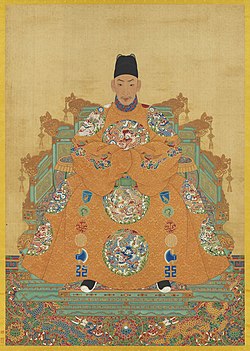| Zhengde Emperor 正德帝 | |||||||||||||||||
|---|---|---|---|---|---|---|---|---|---|---|---|---|---|---|---|---|---|
 | |||||||||||||||||
| Emperor of the Ming dynasty | |||||||||||||||||
| Reign | 8 June 1505 – 20 April 1521 | ||||||||||||||||
| Enthronement | 19 June 1505 | ||||||||||||||||
| Predecessor | Hongzhi Emperor | ||||||||||||||||
| Successor | Jiajing Emperor | ||||||||||||||||
| Born | 26 October 1491 Shuntian Prefecture, North Zhili, Ming dynasty (present-day Beijing, China) | ||||||||||||||||
| Died | 20 April 1521 (aged 29) Leopard Quarter, Ming dynasty | ||||||||||||||||
| Burial | Kang Mausoleum, Ming tombs, Beijing, China | ||||||||||||||||
| Spouse | Empress Xiaojingyi | ||||||||||||||||
| |||||||||||||||||
| House | Zhu | ||||||||||||||||
| Dynasty | Ming | ||||||||||||||||
| Father | Hongzhi Emperor | ||||||||||||||||
| Mother | Empress Xiaochengjing | ||||||||||||||||
| Chinese name | |||||||||||||||||
| Chinese | 正德帝 | ||||||||||||||||
| |||||||||||||||||
The Zhengde Emperor (26 October 1491 – 20 April 1521), also known by his temple name as the Emperor Wuzong of Ming, personal name Zhu Houzhao, was the 11th emperor of the Ming dynasty, reigned from 1505 to 1521. He succeeded his father, the Hongzhi Emperor.
Zhu Houzhao was the eldest and only surviving son of the Hongzhi Emperor. As the crown prince, he received a Confucian education and was known for his intelligence during his studies. However, upon taking power, it became evident that he had a strong aversion to the Confucian-oriented bureaucracy and rejected the rituals and duties associated with it. He frequently clashed with ministers and great secretaries, instead relying on eunuchs, particularly the "Eight Tigers", with whom he had grown up. From 1506 to 1510, the eunuch Liu Jin effectively controlled the government, appointing his allies and supporters to important positions. The emperor even moved out of the Forbidden City to the newly built "Leopard Quarter" where he surrounded himself with eunuchs and officers. After Liu Jin's downfall, the actor Zang Xian (臧賢) and officers Qian Ning and Jiang Bin became the emperor's favorites, while Grand Secretary Yang Tinghe managed the general administration.
The administration of Liu Jin was marked by high tax pressure and a decline in the government's authority, which ultimately led to multiple large-scale rebellions. These included the Prince of Anhua rebellion, the rebellion in northern China that began in 1510, and the Prince of Ning rebellion. The latter was eventually quelled by Wang Yangming, a prominent neo-Confucian philosopher.
As the emperor and eunuchs became increasingly interested in sources of income, they lifted the ban on private foreign trade. This coincided with the arrival of Portuguese sailors in southern China, who began trading with Chinese partners.
In 1517, the emperor spent the majority of his time on the Sino-Mongol border northwest of Beijing, primarily in the garrison town of Datong. During this time, he successfully repelled a major Mongol raid led by Dayan Khan. In 1519, he traveled to Nanjing and remained there for most of 1520. However, on his return journey, he fell into the water while drunk, became ill, and died a few months later.
As the Zhengde Emperor did not have any children, Yang Tinghe, with the support of the deceased emperor's mother, Empress Dowager Zhang, placed his closest male relative, Zhu Houcong, on the throne. Zhu Houcong was only thirteen years old and the son of the Hongzhi Emperor's younger brother, Zhu Youyuan.